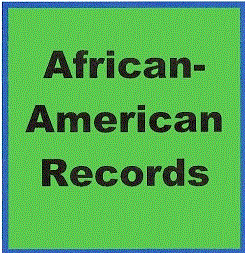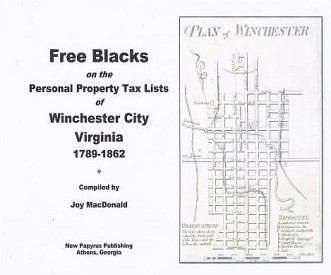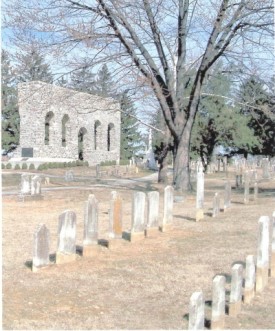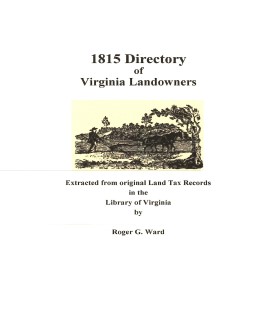






 
Home
Reference
Census Records
Military
African-American
Other States
New Titles
E-BOOKS
FREE SHIPPING IN USA
Iberian Publishing Company's On-Line Catalog:
Independent City of Winchester
Located in Frederick County. First known as Opequon or Shawneetown because of the earlier Indian camp on the site, then as Frederick's Town, Winchester was finally named Winchester by James Wood, first Clerk of Frederick County. According to tradition, it was named after Wood's English birthplace. The first lots for the town were laid out in 1743, the same year that Frederick county began to function as a new county, but it was not until eight years later, in 1752, that the town was chartered by the Virginia General Assembly.
Winchester was ideally situated as a center for the new commerce of the Valley region. It sat astride the Indian trail which brought Pennsylvania Germans down from the north, and an important east-west trade route brought goods and settlers through Snicker's Gap over the Blue Ridge directly to Winchester. From Winchester, a narrower path skirted westward around Little North and Great North Mountains and into the Alleghany uplands of Hampshire County. Winchester grew rapidly and became an incorporated town in 1779 and then a city in 1874. The first train, on the Winchester and Potomac line, reached Winchester in 1836. Because of its vital position to both the confederacy and Union during the war, Winchester witnessed at least 112 engagements during the war, and it changed hands an amazing 72 times (an average of once every three weeks!).
In 1970 a portion of Frederick County was annexed to bring the city to its present size.
Winchester's municipal records date from 1790, but numerous series are incomplete with major gaps.
For a better understanding of county boundary changes, see our new section Virginia in Maps
Iberian also has hundreds of titles in e book (PDF) format!! Click here for a complete online catalog of available titles

 FREE BLACKS ON THE WINCHESTER CITY, VIRGINIA PERSONAL PROPERTY TAX LISTS, 1789-1862 FREE BLACKS ON THE WINCHESTER CITY, VIRGINIA PERSONAL PROPERTY TAX LISTS, 1789-1862
compiled by Joy MacDonald, 2013.11x8 1/2, vi, 377 pages. Paperback; printed on acid-free stock.
The author has abstracted the information for free African-Americans in Winchester City, Virginia and has arranged them into seven categories:
Year;
last name;
first name;
age;
occupation [only given infrequently on the rolls];
property description & value;
memo [oftentimes describing the exact location of the taxpayer or his former owners if freed in recent decades].
This volume is provided in three separate arrangements to facilitate genealogical research by African-American families; 1) chronologically by year; 2) sorted by last name of the individual; and 3) sorted by first name.
A similar volume is available for Frederick County, which was taxed separately from the city of Winchester
Information recorded in Virginia personal property tax records provide a wealth of information regarding the social status of an individual. The early laws required the tax commissioner in each district to record in "a fair alphabetical list" the names of the person chargeable with the tax, the names of white male tithables over the age of twenty-one, the number of white male tithables between ages sixteen and twenty-one, the number of slaves both above and below age sixteen, various types of animals such as horses and cattle, carriage wheels, ordinary licenses, and even billiard tables. Free Negroes are listed by name and often denoted in the list as "free" or "FN." By the 1850s, the personal property tax records contained detailed descriptions of personal property owned.
The most frequent use of personal property tax records is for the direct information recorded: name of the property owner, type and quantity of property owned, and amount of tax paid. Comparative analysis of personal property tax records from year to year may lead to conclusions about social, economic, and agricultural history, as well as the status of certain individuals or groups of property owners within a locality.
For genealogical researchers, personal property tax records may provide important data. Individuals with the same names in a locality may be distinguished by a junior or senior, or residence (often listed by street). Parentage may be expressly or implicitly stated by either the name or number of male tithables between the ages of sixteen and twenty-one in the household of the taxpayer. The names of women appear occasionally when owning property in their own right or as the widow of a property owner. By studying the lists from year to year, researchers may trace an ancestor to determine the date of departure from a locality, or possibly the year of death. The name of a taxpayer will continue on the tax list, noted as "deceased" or "estate," until the estate is settled.
[FBWC] $26.95
The above title is also available as a digital e-book in PDF format:
[EFBWC] $20.00 (electronic version)

 BURIALS OF GRACE LUTHERAN AND GERMAN REFORMED CHURCHES WITHIN MT. HEBRON CEMETERY OF WINCHESTER, VIRGINIA BURIALS OF GRACE LUTHERAN AND GERMAN REFORMED CHURCHES WITHIN MT. HEBRON CEMETERY OF WINCHESTER, VIRGINIA
compiled by the Shenandoah Valley Genealogical Society, 2010.8x10, xiv, 133 pages, maps, index. Paperback; printed on acid-free stock.
FROM THE INTRODUCTION:
Mount Hebron Cemetery, within the city limits of Winchester, Virginia, is the resting place for many of the earliest settlers of the Northern Shenandoah Valley. Officially part of the Virginia Landmark Register, including its dramatic gatehouse, the cemetery is a beautiful tribute to our earliest citizens. Its occupants include its share of Revolutionary War soldiers and their families, and people who deserve recognition as the founding families for the area.
The Shenandoah Valley Genealogical Society organized the project of transcribing all the legible stones that are inclusive of the 2 oldest sections of Mt. Hebron. The cemetery is now made up of 4 sections. The oldest areas are the German Reformed Church and the old Lutheran Church sections.
The Winchester congregation of the German Reformed church was formed under the name of Reformed Calvinists (or German Reform) about 1741. The building for this church no longer exists, but burials are handled through what is now the Centenary United Church of Christ, which sits on the corner of South Cameron Street and Cork Street in Winchester.
The Lutheran Church began building its church near the ruins of the older German Reformed Church in 1764. Following a fire in 1854, the remaining wall of that church still stands. There is a Memorial Garden formed within the lines of the old foundation of the church, and those cremations are included within this list of burials. Grace Evangelical Lutheran Church of Winchester held a fundraiser to restore the remains of the old church wall, create sidewalks, and upright and repair some of the oldest stones. Grace Lutheran Church is currently on Boscawen Street.
Mt. Hebron was created on a five-acre plot of land by the General Assembly in 1844, where the nonsectarian cemetery was built next to the older cemeteries. Following the Civil War, about 1866, another section of Mt. Hebron became the Stonewall Confederate Cemetery, and is believed to be the first memorial Confederate cemetery in the south. There is also a nearby area of Union burials along National Avenue (not considered part of Mt. Hebron). The total of 56 acres now remains a resting place for over 30,000 people.
Information on the history and development of the earliest sections of Mt. Hebron, which is the focus of this publication, can be found at the Stewart Bell, Jr. Archives of Handley Regional Library in Winchester. Newspaper articles, private collections, and photographs may be available as additional resources.
The following list is of the original sections from the two churches and does not include the main cemetery or the Civil War areas. Using the maps included, a researcher should be able to locate the gravesites. Although some more current burials rest along Morgan Lane (labeled as Section N), note that the older stones begin about four rows back from the road, and line up approximately with the Revolutionary War Marker towards N. East Lane. Also note that the plaque at the entryway does not include all the names of those who contributed to the Revolutionary War, and further research will be needed to make that list more accurate.
We hope that the work of diligent and dedicated volunteers who contributed their time and talents to this publication will result in successful researching for generations to come.
Susan L. McCabe
Founding Officer, Shenandoah Valley Genealogical Society
To view a digital copy of the index to this book, visit Index-Bglg
(Close the pdf file with the left arrow to return to Iberian's catalog)
[BGLG] $24.95
The above title is also available as a digital e-book in PDF format:
[EBglg] $18.00 (electronic version)
 Winchester City 1815 Directory of Landowners
by Roger G. Ward. 2005. 18 pages, map, 5 1/2X8 1/2. Winchester City 1815 Directory of Landowners
by Roger G. Ward. 2005. 18 pages, map, 5 1/2X8 1/2.
For a full description of the 1815 LAND DIRECTORY Records and a listing of available counties, see:
Individual County Booklets, 1815 Directory of Virginia Landowners
[Vd49] $6.00
The above title is also available as a digital e-book in PDF format:
[EVd49] $4.50 (electronic version)
For more records pertaining to the Independent City of WINCHESTER, VIRGINIA
see:
|| Virginia/W.Va. || General Reference || Military Records ||
|| Other States || Genealogy Links || New Titles || Home Page || E-Books ||
Copyright 2025 Iberian Publishing Company
|